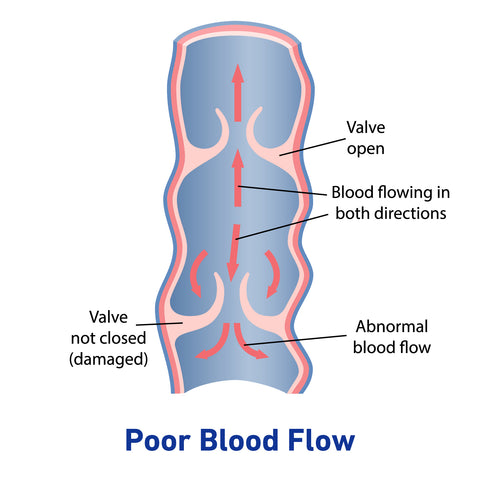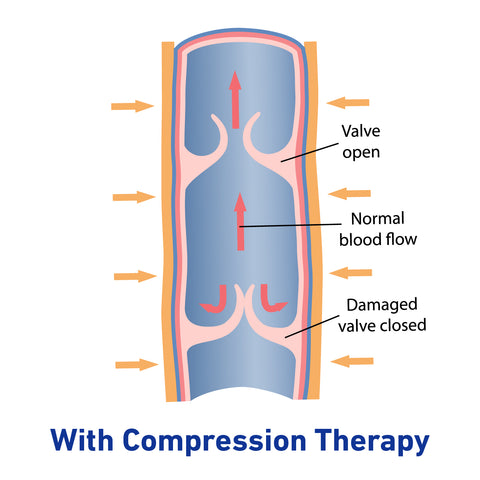How Does Compression Work?
Healthy Blood Flow
Good blood flow is important for keeping skin and tissues healthy. In a healthy leg, tiny valves inside your veins open and close to ensure blood moves around the body in the right direction.
What does this look like?

Leg muscles contract - Movement causes muscles in the legs and feet to contract and relax.
Valves open - When the muscles contract, valves inside the veins open causing blood to flow towards the heart.
Valves close - When the muscles relax the valves close, preventing back flow of the blood.
Poor Blood Flow
If these valves become damaged, blood can flow backwards, causing veins to stretch and swell. Poor blood flow can cause pain, enlarged veins, burst capillaries, tissue inflammation and damage, and even infection. It can also stop any wounds on your legs healing as well as they should.
What does this look like?

Leg muscles contract – Movement causes muscles in the legs and feet to contract and relax.
Valves open - When the muscles contract, valves inside the veins open causing blood to flow towards the heart.
Damaged valves unable to close - Damaged valves allow back flow of blood and cause swelling of the leg
With Compression Therapy
Compression therapy counteracts poor blood flow by applying a firm continuous pressure to the muscles and veins in your legs. It exerts more pressure at the ankle to encourage blood to flow up the leg.
What does this look like?

Leg muscles contract - Compression therapy helps to support the muscles during contraction and relaxation.
Valves open - Vein walls are pushed closer together allowing damaged valves to operate correctly.
Damaged valves close - When the muscles relax the valves are able to close fully, preventing back flow of the blood.
Compression hosiery comes in various styles, lengths and compression levels but ultimately they all work in the same way. By providing a firm, continuous pressure to the muscles and veins in the leg with more pressure being exerted at the ankle, blood is encouraged to flow up the leg. By helping blood flow back towards the heart, the compression socks support the natural function of the valves in the veins and therefore reduce the occurrence of blood pooling in the lower extremities.
Benefits of Compression Therapy
-
Relieves tired, achy legs
Compression socks can help to improve and relieve symptoms such as swollen, tired, or achy legs at the end of the day.
-
Supports your veins
Compression hosiery supports your veins by helping improve venous return to the heart, preventing the backflow of blood.
-
Contains swelling
Swelling in the limbs, (chronic oedema), is contained and reduced when wearing compression socks.
-
Prevents disease progression
Compression socks have been proven to prevent venous disease from progressing.
-
Reduces recurrence
Wearing compression hosiery post leg ulcer healing has been proved to reduce the risk of an ulcer recurring by helping to manage venous and lymphatic insufficiencies.
-
Keeps legs healthy
Long periods of standing or sitting may increase your risk of developing symptoms of venous disease, such as varicose veins. Wearing compression hosiery can reduce this risk and help to keep your legs healthy.
-
Supports everyday activities
Compression hosiery can be worn to support your legs during everyday activities such as; for sports, when exercising, at work, when flying or travelling etc.
-
Reduces symptoms during pregnancy
During pregnancy, swelling in the limbs increases along with the risk of developing venous disease. Wearing compression socks helps to manage and prevent these symptoms
To learn more about which compression hosiery is right for you, read our buying guide.















